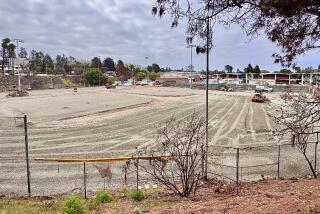Belmont: Take the Next Step
- Share via
The Los Angeles Unified School District is asking teachers, students, parents and other taxpayers to trust that it can capably and safely complete the Belmont Learning Complex despite its poor history on a project that has been nothing but a trail of trouble and broken promises. That’s a big leap. But it may be possible if the district can negotiate an agreement with a competent developer that guarantees safety, an ironclad maximum cost, unyielding independent oversight and full liability protection over the life of the high school. That is what Supt. Roy Romer says he can deliver. If so, it will be a 180-degree turnaround for the school district.
The new Belmont was supposed to open in 1999, allowing thousands of students bused away from overcrowded neighborhood campuses to stay closer to home. They’re still waiting. Romer is set on resurrecting Belmont, now a collection of half-finished buildings sitting on an abandoned oil field contaminated with potentially explosive methane gas. In theory, well-tested technology exists to fix the environmental problems, which were ignored during the original construction. In practice, completing this school just west of downtown will require a dedicated “A team” of outside experts to design, build, operate and maintain it safely. Such an expectation would have been laughable a few years ago, under the different leadership that led Belmont to disaster.
Today, it is a serious question for the school board, which is scheduled to vote on it Tuesday. The board should allow the superintendent to negotiate a contract with his chosen developer, then it should evaluate the results and go from there. What the board and the state’s safety overseers need to see are a firm contract and, after that, detailed plans.
There is an old rule of thumb for estimates for huge public projects. It goes like this: Double the numbers. Double the time. Hold your breath. That applies easily to Belmont. In 1994, the original estimate was $60 million. The district has already spent $154 million, and the proposed fix is estimated to cost $67 million to $87 million. No numbers can be trusted until the district negotiates a fixed maximum price from a developer willing to assume the risk.
The design, the construction, the monitoring and everything else must be approved by the California Department of Toxic Substances Control, the state agency that originally recommended a halt to the flawed project. State law now gives substantial jurisdiction over this project to the department, which has a reputation for upholding public health and safety. One promising suggestion would have USC engineering professors monitor a new venting system, starting with design and continuing for the long term.
If each step is successfully completed in the fullest possible public view, public confidence will incrementally return. The district’s tentative successes on primary-grade reading scores and its starts toward building other schools are causes for hope.
Romer understands that his reputation is on the line and that any new Belmont failure would be disastrous not just for the school system but for the city. That said, the school board should launch the next step of this project but not provide any blank checks.
More to Read
Sign up for Essential California
The most important California stories and recommendations in your inbox every morning.
You may occasionally receive promotional content from the Los Angeles Times.













